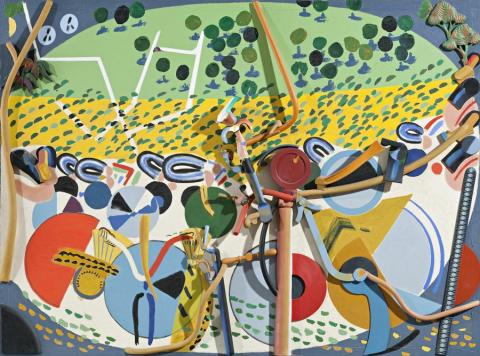CYCLISTS IN THE PARK, 1990
Colin Lanceley
oil and wood on canvas
164.0 x 221.0 cm
signed with initial lower right: 'L' signed, dated and inscribed verso: 'CYCLISTS' CIRCLE - CENTENNIAL PARK' Colin Lanceley SYDNEY 1990
The Mecenat Collection, Sydney
Company collection, Sydney
Frumkin/Adams Gallery, New York, 1-30 March 1991 (label attached verso)
Selected Recent Works, Sherman Galleries Goodhope, Sydney, 19 August - 18 September 1993, cat. 1
Stringer, J., Colin Lanceley, exhibition catalogue essay for Frumkin/Adams Gallery, New York, 1991 (illus.)
Hawley, J., ‘Art and Nothing But', Good Weekend, 2 March 1991, p. 19 (illustrated with the artist in studio)
Hughes., R. and Wright, W., Colin Lanceley, (revised edition) Craftsman House, Sydney, 1993, pp. 110–111, pl. 41 (illus. and front cover)
Colin Lanceley's works are the embodiment of 'joie de vivre'! His subject matter and working methods exclaim a passion for life and colour, and of his ability to make into form a moment of observation captured from a touching or exciting, if fleeting event. In a letter from the artist to the previous owners of Cyclists in the Park, the artist writes, 'Cyclists in the Park' which I also refer to as 'Cyclists Circle', is that moment when racing cyclists, bunched in formation, jostling and yelling at each other rush past at speed in a phalanx of helmeted heads, bright colour shirts and shining lycra shorts on Grand Drive in Centennial Park in the early morning.'1
The artist's joy of colour, tuned intuition and sophistication of structure is further observed by Robert Hughes in the monograph Colin Lanceley, on which Cyclists in the Park is the cover illustration:
'Their immense strength is in their colour, so wide-ranging, structurally integrated and sure in its effects: with a few exceptions... there are no artists in Lanceley's generation to whom the diction of colour seems to come so naturally, across a whole range of intentions from the purely optical to the metaphoric. Lanceley, here as elsewhere in his work, is an intuitive painter, true to the precepts of the man he most admires. 'The choice of my colours,' wrote Matisse in 1908, as he was issuing from the apparent convulsions of Fauvism into the grander air of monumental decoration, 'does not rest on any kind of scientific theory; it is based on observation, feeling, on the experience of my sensibility.' One recognises this modest-looking but deeply ambitious intent in Lanceley; and that is why his recent paintings, in their exchanges between inherited language and fresh insights, offer relief from both the dismal bombast of most neo-expressionism and the bony ideological prattle of most post-structuralist art.
When Lanceley quotes 'which he does from a considerable range of sources, some well-known like Matisse and Gaudi, others local and obscure, like the high-horizon-line paintings of David Davies' you can see him disporting in the fact that there is so much art language to know and to draw on. You never get the dead-end feeling, common to so much post-modernist art, of having strayed into a theatre of soured erudition where everything is experienced in its simulacrum, through reflection from other media. If Lanceley's optimism about the modernist inheritance seems not up to the minute, then so much the worse for the minute. To be intelligently committed to the pictorial, in the late 1980s, is neither a small nor a retrograde thing.'2
1. Letter from Colin Lanceley to previous owners
2. Hughes, R. and Wright, W., Colin Lanceley, Craftsman House, Sydney, 1993 (revised edition) p. 17
